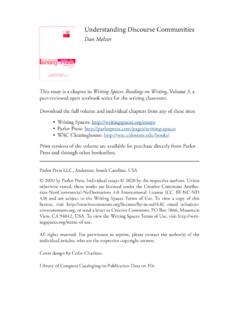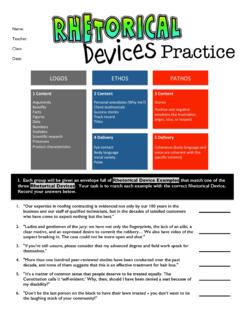Transcription of English Language & Composition Lesson Plans: Reading ...
1 Denise Rodriguez English Language & Composition AP Teacher James Pace High School Brownsville, Texas EEnngglliisshh LLaanngguuaaggee && CCoommppoossiittiioonn LLeessssoonn PPllaannss:: RReeaaddiinngg,, WWrriittiinngg aanndd PPiiccttuurriinngg LLiitteerraattuurree Unit Overview This unit is comprised of four activities for 11th grade English and AP English Language and Composition courses: (1) A close Reading and stylistic/rhetorical analysis of Hernan Cort s s Second Letter to Charles V (included in this document: teacher instructions, Reading , student worksheets) (2) Templo Mayor WebQuest (see link on Web site) (3) Poetry assignment, linking poetry from Aztec times to modern poetry and song lyrics (PowerPoint can be downloaded from Web site) (4) A Vision of Literature, media-based assignment using technology to understand literature (included in this document: teacher instructions, student handouts) This series of activities was designed to enhance the Reading and understanding of Hernan Cort s and his invasion of Tenochtitl n.
2 The final assessment for this project is the essay written in response to the following prompt: How does Hernan Cort s s style of writing convey the Spaniards attitude toward the Aztecs and their way of life? Once students have completed the activities, they will be able to answer this question with ease. Not only will they have studied Cort s s words, they will have a thorough understanding of the Aztec culture as well. Please use all activities when working with this project. Course Standards and Skills English Language ARTS, English III - Grade 11 Reading selections from The Language of Literature American Literature 11th grade (LL) Weekly Standards highlighted text Texas Essential Knowledge and Skills 1A,B; 2C; 3A,B; 4A,B,D,E,F; 6B,E,F; 7A,C,D, E,F,G,H; 8A,B; 9A; 10A,B; 11A,B,C,D,E,F; 12A,B,C; 13C; 14C; 15B,F; 17E; 18A,C; 19A,B; 21A Objectives TLW understand / recognize author s purpose; understand & appreciate sacred song/folktale/short story/personal narrative; appreciate use of repetition; recognize author s use of conflict; make inferences; understand the structure of a personal narrative; examine how audience influences author; use text organizers; understand and appreciate historical chronicle; examine primary sources.
3 Analyze details; draw conclusions; understand & appreciate an autobiography Reading /Critical Thinking/Literary Devices/Skills Focus: Early Beginnings Creation myth, song, folktale (trickster tale), cause & effect, characterization, irony, short story, conflict, inferences, personal narrative, setting, understanding structure, historical narratives; audience; text organizers; primary & secondary sources; summarizing; details, conclusions, autobiography, author s purpose Literary Selection Choose from: Of Plymouth Plantation /chronicle pg. 77 Women and Children First: The Mayflower Pilgrims /related Reading The Interesting Life of Olaudah Equiano / slave narrative Hernan Cort s: Second Letter to Charles V Novel Reading : The Scarlet Letter Choose from: Reflective essay Resume Writing Argumentative essay Writing/Research Research: Early Explorers Voyage of the Pilgrims Description of place Oral story telling Listening/Speaking Viewing/Representing Art (Diego Rivera) Art appreciation (Diego Rivera) Enrichment Grammar Review as needed: -Parallelism -Passive Voice -Subordination Techniques -Quotations with ellipsis points LL pg.
4 64 Sentence crafting-parallelism LL pg. 991 BK English : Persuasive Essay Ch. 9 pg. C408 Excerpt from the Second Letter to Charles V (1520) Hernan Cort s AP English Language & Composition Teacher Overview Skill Focus Critical Thinking Remember understand Apply Analyze Evaluate Create Close Reading Grammar Composition Reading Strategies Annotation Determining Author s Purpose Determining Main Idea Generalization Inference Literary Elements Detail Style Theme Figures of Speech Metaphor Personification Literary Techniques Literary Forms Nonfiction (autobiography) Mechanics Punctuation Usage Phrases Participial Clauses Sentences Complex Compound Compound-complex Simple Sentence Variety Sentence Beginnings Syntax Techniques Parallelism Repetition Analysis of a Text Meaning and Effect related to phrases, clauses, sentences, and syntax Rhetorical Analysis focused on syntax Types (Modes) Expository analytical The Process of Composition Prewriting generation of ideas Structural Elements Introduction thesis Overview: Hernan Cort s s Second Letter to Charles V This Lesson revolves around the stylistic and rhetorical analysis of Hernan Cort s s Second Letter to Charles V, written in 1520.
5 This excerpt, in conjunction with the study of William Bradford s Of Plymouth Plantation, becomes a comparative study to give students knowledge and understanding of literature from their textbook and literature connected to their culture. Part of the Puritan unit discussed in my AP Language class focuses on the religious plight of the Puritan movement to Salem, Massachusetts. The students study, in depth, Puritan religion and first encounters with the Indians of America; however, the perspective of the Indians in American history has always been somewhat of a mystery. In the study of American history through literature, one of the first passages students are given is an excerpt from William Bradford s Of Plymouth Plantation. This passage portrays the trials and tribulations of the journey to a land unknown to the Puritans.
6 The purpose of this Lesson is to explore the similarities and connections of the Puritan/Indian first meeting with the first meeting of Hernan Cort s and the Aztec Indians of Mexico during the 1500s. Lesson Introduction I write this introduction to provide insight into why I am so passionate about teaching and what I, as a learner myself, can offer students in my community or any other community I teach. This is a guide to how and why I devote so much of my time and energy to the students and community with whom I work. Let s face it: part of my reality is having a classroom of students who come from broken homes, are first-generation Americans, and have uneducated families. I am aware of the tribulations my students face because, as a Hispanic woman, I have faced them as well.
7 The students in my classroom range in age from 16-21 and although they have a broad range of experiences, culture to them is eating tortillas, speaking Spanglish, and attending a quincea era as the social event for the weekend. As an English teacher, I consider myself fortunate to have a broad array of resources dealing with Language , arts, and history to develop an understanding of culture through literature. Many of my colleagues focus predominantly on Hispanic culture in the classroom because they feel that this is the only thing our students can comprehend; I, on the other hand, feel that my students need to be exposed to much more. I do foster learning about Hispanic culture. However, I do not direct learning to facilitate what is comfortable for my students but rather to address what is challenging.
8 This allows my students to become well-versed in a view that expands beyond our borderland and comfort zone. Exposure is key; exposure is critical. For my students to be successful in all endeavors, whether raising a family in Brownsville, Texas or working on Wall Street, the literature I present will help them broaden their horizons. This is my responsibility; this is my role. Considering the background of my students, comparing American history and literature to the history and literature of their ancestry can help foster connections to challenging literature thus, this Lesson . Reading for Rhetorical Devices This Lesson will provide a review for most students who were in a demanding Pre-AP English class. The passage s simple Language and syntactical patterns, plus Cort s s use of so many rhetorical devices, make it an ideal vehicle for teaching style analysis while providing a description of Aztec society.
9 The handouts for students include the Student Activity and the excerpt from Cort s s letter. One of the terms introduced in this Lesson is parallelism. Teachers should teach the chapter called Parallelism in Prose Style concurrently with this Lesson . The Cort s passage is rich in rhetorical devices, some of which are discussed below. Students will eventually study all of these devices in two ways. First they will become more sensitive to the way authors use these devices to create a certain effect in their writing. Then they will learn to use these devices in their own writing to write prose of sufficient richness and complexity to communicate effectively with mature readers (from College Board s description of an AP Language course). Following is an in-depth discussion of some of the rhetorical devices: I.
10 Beginning sentences with a coordinating conjunction But not to be prolix in describing what relates to the affairs of this great (paragraph 14) For, as I have already stated, what can be more wonderful than a barbarous (paragraph 15) But as nearly as I have been able to learn, his territories are equal in extent to Spain (paragraph 15) Cort s begins several sentences with a coordinating conjunction to give the sense that he is telling a story, adding details about the Aztec empire laid before him. Cort s uses many compound sentences, employing coordinating conjunctions within the sentences. The prose is straightforward and rather plain, befitting a people who saw God s hand in everything that happened to them and praised Him even for their trials. Cort s begins new sentences with coordinating conjunctions for the practical reason that he has combined so many independent clauses with coordinating conjunctions that he is obliged to begin another sentence.









